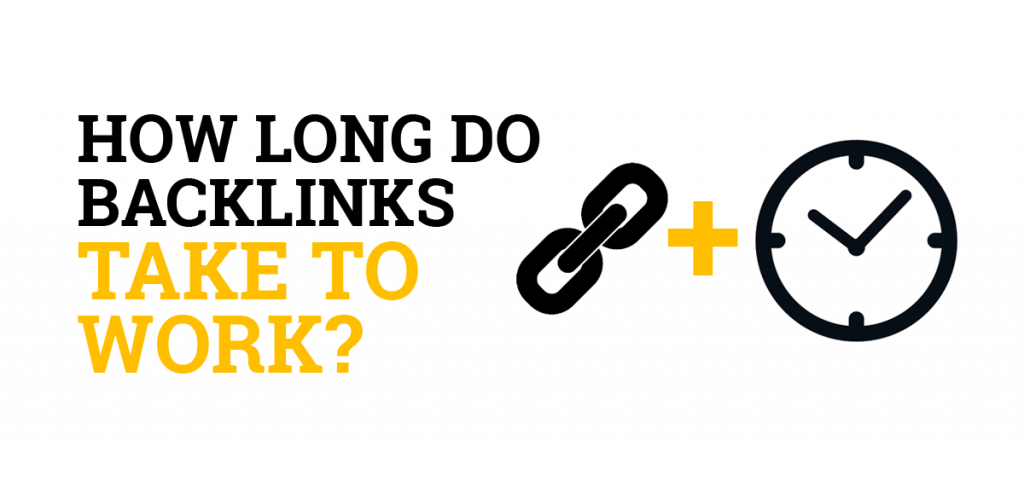How long does it take SEO back-links to work for new and existing websites in 2022? How long do back-links take to build a site’s domain authority? And how long does it take back-links to start getting organic traffic?
In this article, we’ll answer the question, “how long do back-links take to work?”
And this is an important topic to cover because so many people wonder how long does it take for back-links to take effect to see a noticeable increase in ranking positions in the search engine results pages (SERPs).
Will a new link take effect immediately?
Or within a few days?
Or will you have to wait several weeks or months to see the impact of your link building?
You’ll get all of those answers and more in this complete guide on the speed of back-links for search engine optimization (SEO).

How Long Do Back-links Take to Work?
It takes backlinks an average of 10 weeks to work for SEO on a link-by-link basis. But if you build several backlinks at once, then the effect will happen faster. Three attributes that control the speed that a backlink works: domain authority, keyword competitiveness, and the type of link.
For some websites, the answer for how long does it take for backlinks to take effect could be closer to five weeks or even just a few days. You have to remember that each backlink on its own typically has a lower effect initially, but the power of that link increases over time.
If you get a large number of backlinks at once, you’ll typically see faster results of the backlinks working to increase your ranking positions in the SERPs for competitive keywords. Plus, you’ll see much bigger effects over time as the power of those links compound on each other.
However, for low competition keywords, you may only need a few backlinks to increase your position on Google, Yahoo, or Bing. And, the lower your current rankings, the more effect each backlink will have.
For example, a web page sitting at position #40 for a target keyword that gets a single high-quality backlink may increase to position #20 or higher after that link is crawled, indexed, and the PageRank value is transferred to the target site. And this can all happen in a matter of days or weeks depending on the factors listed below.
How Long Does It Take for Backlinks to Get Indexed?
It can take as little as 4 days and up to 6 months for backlinks to get indexed. Search engine crawlers work at different speeds for every website and each site has its own crawl rate and crawl budget which determines how fast backlinks get indexed.
What Factors Affect How Long a Backlink Takes to Work?
Crawl Rate
Crawl rate refers to the number of requests per second Google’s search engine crawler (Googlebot) can make to your site when during a crawl, such as 5 requests per second.
Google has a sophisticated algorithm that can determine the best crawl rate for your website so it doesn’t overwhelm your server’s bandwidth. Also, there are two key factors that impact the crawl demand:
- Popularity: URLs that are more popular on the Internet tend to be crawled more often to keep them fresher in our index.
- Staleness: URLs with outdated content are usually crawled less often than content that’s updated frequently to help keep stale content out of the index.
According to Google, “You cannot change how often Google crawls your site, but if you want Google to crawl new or updated content on your site, you can request a re-crawl.” This is done through the URL inspection tool in Google Search Console.
Crawl Budget
Crawl budget is the number of pages Googlebot will crawl on your website within a given time-frame. Google doesn’t crawl every web page each time it visits your website.
There are several factors that affect a site’s crawl budget:
- Crawl Limit/Host Load: How much crawling the website server can handle and the site owner’s established preferences.
- Crawl Demand/Crawl Scheduling: Which URLs are worth re-crawling the most based on popularity and how often it’s being updated.
- On-Site Duplicate Content: When duplicate content is detected, such as through variations caused by URL parameters, Google group the duplicate URLs into one cluster and crawl each page less often.
- Soft 404 Error Pages: These can limit a site’s crawl budget because these duplicate URLs may be crawled instead of pages with unique content.
- Infinite Spaces: Pages that provide little or no new content for Googlebot to index, such as the “Next Month” page on an infinite calendar or filtering tools on ecommerce sites for things like category, price, color, brand, style, etc that create infinite combinations of web pages.
- Low Quality Content: Content that doesn’t provide significant enough value to get ranked in the index can cause a delay in Googlebot discovering great content on a site that should be indexed and ranked in the search engine.
Domain Authority
Domain authority (DA) refers to the strength of an entire domain by evaluating multiple factors, including linking root domains and the total number of backlinks to the website. DA was initially created by Moz and now other SEO tools like Ahrefs and Semrush have their own version of it for SEO analysis.
Domain authority is based on a 1-100 scale with the higher numbers indicating a strong domain that can pass more PageRank to a target site through a backlink.
Page Authority
Page Authority (PA) measures the strength of individual web pages based on a 1-100 scale. A higher score corresponds to a greater ability for a web page to rank in the search engines, which also correlates to a stronger PageRank value that can be passed through a backlink on that page to the target site.
Type of Link
There are two types of links on the Internet: dofollow vs nofollow links.
Dofollow links carry much more SEO weight than nofollow links. And a single dofollow link from a website with a high domain authority and/or page authority can make a backlink work faster for SEO.
Keyword Difficulty
Not all keywords are created equal and each term has its own competitiveness. The common term for this is keyword difficulty (KD) which is an SEO metric used to determine how difficult it may be to rank for a target keyword.
Some keywords have a low KD score between 0-20 and a web page that’s targeting that keyword may only need a few backlinks to see an effect in the ranking positions in the SERPs. Plus, the rate of speed at which these backlinks work is typically faster; a few days up to 5 weeks.
On the other hand, web pages that target keywords with a higher KD score between 50-100 will often require a large number of high-quality backlinks to move the URL up in the SERPs. And these backlinks usually take many weeks, if not months, to move the needle for these websites.
Link Relevance
The relevance of the backlink can also affect the speed at which your links take effect.
When it comes to link building, it’s better to have 5 backlinks from highly relevant sites and/or content than it is to get 20 backlinks from off-topic sites or web pages.
As noted in this article on Go Fish Digital by Bill Slawski about a Google patent update, “One of the noticeable things that is new in the claims in this continuation patent is the mention of Annotation text, within a certain distance from anchor text for a link, which could influence what a page that is being linked to maybe about.”
Therefore, when you’re trying to affect the power and speed of your backlinks, you should pay close attention to the relevance of the website and/or web page the link is placed on in. The Google patent update seems to indicate that the words within a certain distance of the backlink anchor text are also indexed to better understand the meaning of the linked page.
Link Velocity
Link velocity is the speed at which you acquire new backlinks and it’s an important topic covered in this article on how many backlinks per month is safe.
Many people in the SEO community believe that a high rate of link velocity (or growth) is a bad thing for a website. But it’s not true when those links are built organically and/or within Google’s Webmaster Guidelines.
In fact, when you want backlinks to take effect faster, then you should increase your link velocity as much as possible. As mentioned earlier in this guide, you can get a large number of backlinks all at once, or within the same month of each other, you’ll typically see faster results of the backlinks working to increase your ranking positions in the SERP for your keywords.
And if you’re curious about how many backlinks per day is safe to create, check out that linked guide as well.
Anchor Text
The anchor text you use for your backlinks can also influence how long it takes your backlinks to work.
A keyword-rich backlink on a website with high domain authority or web page with high page authority can be much more beneficial than a link that’s not properly optimized for your target keyword.
However, you also want to follow a strict anchor text ratio optimization strategy to prevent over-optimization to avoid a Google manual action or algorithm penalty. See that linked guide for more details about that anchor text ratio.
How Long It Takes Backlinks to Work Summary
I hope you enjoyed this guide answering the question about how long do backlinks take to work for SEO.
As you discovered, the average time for how long does it take for backlinks to take effect to a ranking change in the SERPS is 10 weeks; however, you can see results much faster (e.g., a few days up to 5 weeks) if you compete for low competition keywords and/or build your backlinks at a faster link velocity.
The post How Long Do Backlinks Take to Work? (Effect On SEO Answered) first appeared on SEO Chatter.
About Lead Generation SEO Services…
We are media and company growth strategy specialists. How we can help your business:



